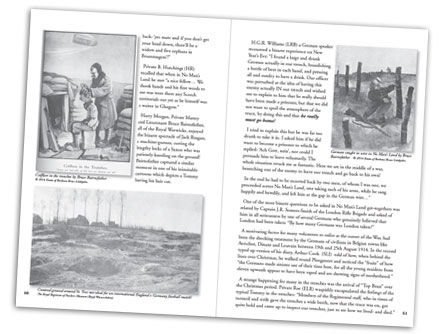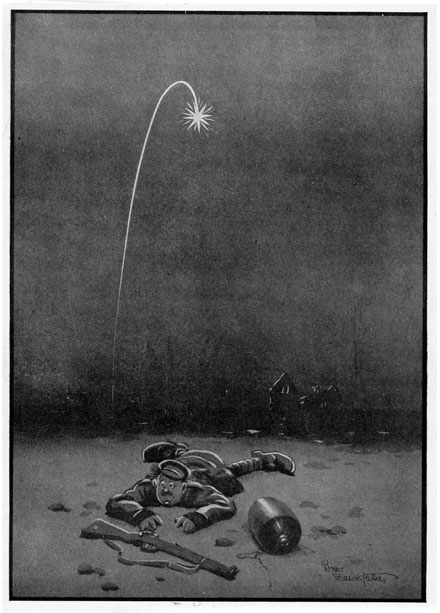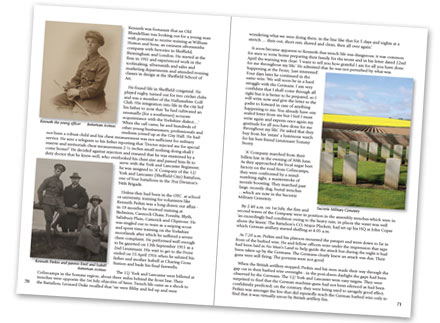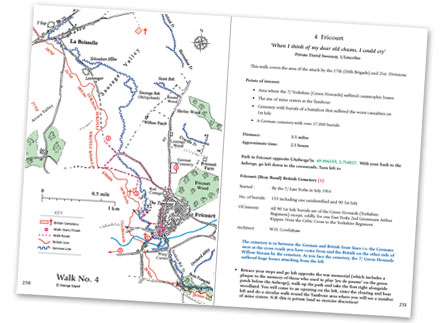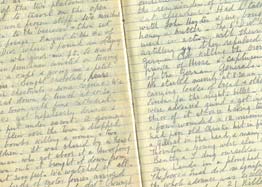

Excerpts from the books
Meet at Dawn Unarmed
December 7th
Soaking wet day and alas the trenches tonight. Wood and I managed, by making ourselves charming to a S.M. of the A.S.C. to get a little paraffin. All the ‘A’ company officers had a most excellent lunch at an estaminet. I determined to get a conveyance of sorts to carry some of the men’s extra blankets and odds and ends of things that make life bearable in these saddened trenches, and to have if possible something dry when we get there after a four mile march in a drenching downpour, with mud over our ankles all the way. Commandeer an old horse and if possible an older brougham. The springs on one side were broken, likewise both windows. A Belgian boy as a driver. Ten minutes after it arrived at the billet, it was loaded sky high. Frying pans and pots were tied on to the handles of the doors, neither of which would open. Inside were blankets and sacks, a lusty cockerel or two, and some rabbits or Belgian hares, and the whole in charge of Jimmy Long, Wood’s servant and also the company wit. They were loudly cheered going through the village. They started 3 hours in advance and got there half an hour before us, after one of the most thrilling adventures (as told by Jimmy Long) ever recorded. The crazy cart tipped over once and blocked the narrow lane against a battery of artillery returning to their snug billets for the night. Long seems to have given the officer in charge a good piece of his mind under cover of the darkness. The cocks crowed all the way, and the pots and pans, banging against each other were sufficient warning for miles. Long was much more mud than clothes, but cheery as a lark. The horse ‘A company pet’ as Long christened him, was none the worse and was found later having a good meal on the company ration biscuits.
December 11th
It rained all night and the whole of today. When
I went round the sentries I found them quite resigned to another flood. They were amused. One Pte. Carter said “it will lay the dust, sir, won’t it?” at which I laughed heartily and so did they. But poor fellows they were on their last legs for this trench trip. Cave had to spend the day and night in my dug out as his was flooded. Thanks to my Black Hat gang of the deepest drinkers and worst of characters (in peace time) in the company, my dug out was the only one dry. The men are trying to build dug outs with sandbags only.
Christmas Day 1914
Private Harry Morgan pinched himself again- he had now been in France for nearly two months and after the hell of life in the trenches he had found the whole experience unbelievable. Before dusk, one of his officers came through the trenches Father Christmas-like, presenting every soldier with a gift from H.R.H. the Princess Mary: an embossed box, which contained a pipe, six cigarettes, an ounce of tobacco, a tinder lighter, a Christmas card and a photo of the Princess and the King. “Bless her heart” he murmured in appreciation.
In Leutnant Zehmisch’s section of No Man’s Land, one of his subalterns, N.C.O. Holland took three photographs of mixed groups of English and German troops. Not long afterwards, a couple from ‘C’ Company brought out a football and using caps as goalposts started an impromptu and rigorous ‘international’ match. Handshakes followed and an honourable draw agreed until they returned to their trenches when, of course, victory was claimed.
In the late afternoon, efforts were made to arrange a grand Boxing Day match between the best players from the English and German Companies. Zehmisch regretted that a fixture might not be possible as he and his Company were scheduled to be relieved and a new officer would be in command.
Sergeant Philpotts engaged in a conversation with a German soldier who had been a chef in Birmingham and had left his wife and five children there when he travelled to the Front.
After dusk, soldiers on both sides mulled over what had happened. Tapp and three other officers’ servants were of one mind that it had been an extraordinary day. He was amazed at how different it had been to recent Christmas Days he had spent, especially the one in 1910 when he had stood under the mistletoe with the girl he later married. The fraternisation in No Man’s Land had been ‘strange and unbelievable’. He had been struck by the superb Christmas lunch they had concocted and said to his colleagues- ‘I hope everyone back home in England has as good food for their Christmas Day.’
Stolen Lives
Extracts from the chapter about a famous actor, Basil Hallam Radford (stage name Basil Hallam) whose death was one of the most unusual in the Great War.
Basil Hallam Radford (stage name Basil Hallam)
‘Gilbert the Filbert, the Knut with a K’
Basil Hallam took his bow to rapturous applause for his performance in The Passing Show revue at the Palace Theatre in London’s West End. When he left later by the stage door, he was handed some white feathers, the guilt-provoking symbols of cowardice. It was a tiresome contrast to the reaction of another packed audience and he wearied of the sneered comments about his failure to respond to Lord Kitchener’s call to arms. His door-stepping detractors were probably ignorant of the fact that eight months earlier, when war had been declared, he had attempted to enlist but was rejected, due to having had an instep smashed in his foot when only nine years of age which had necessitated the use of a steel plate in his right boot. As only the physically fit were recruited at that early stage of the War, Basil Hallam had little choice but to continue his work on the stage.
Basil Hallam’s appeal was such that he was never short of female admirers like Diana Manners, the young socialite daughter of the Duke of Rutland, who described him as ‘her little stick of barley sugar’. According to Philip Ziegler, she fell for his ‘dreamy charm’ and after parties, he ‘would linger and take Diana home in the early hours professing his love.’ In her autobiography, she admitted that ‘I should have liked to have danced all night with Basil Hallam, being a little in love with him.’
Basil Hallam Radford was a celebrity and according to E.B. Osborn ‘at the outbreak of war, Gilbert the Filbert was the most popular character on the English stage.’ His decision to enlist was a great fillip to the recruiting authorities. Initially he joined Motor Transport but was considered fit enough to join the Royal Flying Corps Kite Balloon Section; his training started on 23 August at Roehampton and he was commissioned on 20 September as a 2nd lieutenant.
By now a captain, Basil Hallam Radford and 2nd Lieutenant Moxon, were winched up in a stiff wind west of the Ancre Valley on 20 August 1916. There are several contemporary descriptions of the incident. Rudyard Kipling described the incident in his History of the Irish Guards in the Great War: ‘On a windy Sunday evening at Couin in the valley north of Bus-les-Artois, the men saw an observation balloon, tethered near their bivouacs break loose while being hauled down. It drifted towards the enemy line. First they watched maps and books being heaved overboard, then a man in a parachute jumping for his life, who landed safely. Soon after, something black, which had been hanging below the basket, detached itself and fell some three thousand feet. We heard later that it was Captain Radford (Basil Hallam). His parachute apparently caught in the rigging and in some way he slipped out of the belt which attached him to it. He fell near Brigade Headquarters. Of those who watched, there was not one who had not seen him at the “Halls” in the immensely remote days of “Gilbert the Filbert, the Colonel of the Nuts.”’
Moxon landed safely and later wrote Elsie ‘a most beautiful letter giving me the details. “I never thought”, he said “it would be Gilbert the Filbert who would give me the courage to face death!”’ John Davis (he of spats fame) informed her that ‘although practically every bone was broken from the impact, his face was untouched and he was almost smiling.’
Kipling’s and Moxon’s versions were confirmed by a letter written on 22 August by Grenadier Guard Raymond Asquith, the Prime Minister’s son, to Diana Manners. ‘I cannot end without telling you that the day before yesterday Basil Hallam was killed before my eyes by falling 6,000 feet or so from an escaped balloon. He came to earth in a village half a mile from where I stood… shockingly foreshortened, but recognisable by his cigarette case. His companion descended more gradually by parachute. I saw Edgy Knollys today who had come from burying him. A frightening death even to look at.’ It would appear that Davis’s account hid from his friend Elsie Janis the true state of Basil’s body.
It is hard for us to comprehend one hundred years after the event, that a ‘celeb’ played his part in the war effort alongside his fans who would have been whistling or playing his latest hits. Raymond Asquith in curmudgeonly mood wrote: ‘Our band has just arrived and is playing out in the square. It is extraordinary what a difference it seems to make to the men and to all of the officers except me. They stand in the cold for hours listening to it playing “Gilbert the Filbert” or any other nonsense, and talk about it afterwards too as if it were an important event.’
The death of the much loved and famous actor Basil Hallam Radford was appropriately dramatic. His final curtain call was before a disbelieving and horrified audience, not admiring a star performance by an established star but stunned by the hopeless and tragic fall of an unknown observation balloonist to a shocking and instant death.
We Good...We No Shoot
Excerpts from a chapter about meetings in No Man's Land
Several of the Royal Warwicks met a German who had worked as a waiter in Eastbourne for ten years who wished he was back there. Many Germans were based in England before the War. Private Day (RWR) met several who had lived in London. According to Rifleman Jack Chappell ( LRB), his friend Russell “was introduced to a barber in the Strand named Liddle.” Serjeant Philpotts (RWR) spoke to a German chef from Birmingham who at the outbreak of war had been forced to leave his wife and five children when called up for front line action. Philpotts recounted for the 1964 BBC Great War Series how, when hostilities resumed in January 1915, a voice could be heard loud and clear from the German line: ‘“Are you the Warwicks? Any Brummagem lads there? I have a wife and five kids in Brummagem.’ Our company wag who in civil life was a policeman, called back: ‘yes mate and if you don’t get your head down, there’ll be a widow and five orphans in Brummagem’!”
Private B. Hutchings (HR) recalled that when in No Man’s Land he met “a nice fellow… We shook hands and his first words to me was were there any Scotch territorials out yet as he himself was a waiter in Glasgow.”
Harry Morgan, Private Mattey and Lieutenant Bruce Bairnsfather, all of the Royal Warwicks, enjoyed the bizarre spectacle of Jack Reagan, a machine-gunner, cutting the lengthy locks of a Saxon who was patiently kneeling on the ground! Bairnsfather captured a similar moment in one of his inimitable cartoons which depicts a Tommy having his hair cut.
H.G.R. Williams (LRB) a German speaker recounted a bizarre experience on New Year’s Eve: “I found a large and drunk German actually in our trench, brandishing a bottle of beer in each hand, and pressing all and sundry to have a drink. Our officer was perturbed at the idea of having this enemy actually IN our trench and wished me to explain to him that he really should have been made a prisoner, but that we did not want to spoil the atmosphere of the truce, by doing this and that he really must go home!
I tried to explain this but he was far too drunk to take it in. I asked him if he did want to become a prisoner to which he replied: ‘Ach Gott, nein’, nor could I persuade him to leave voluntarily. The whole situation struck me as fantastic. Here we are in the middle of a war, beseeching one of the enemy to leave our trench and go back to his own!
In the end he had to be escorted back by two men, of whom I was one, we proceeded across No Man’s Land, one taking each of his arms, while he sang happily and bawdily, and left him at the gap in the German wire…”
One of the most bizarre questions to be asked in No Man’s Land get-togethers was related by Captain J.R. Somers-Smith of the London Rifle Brigade and asked of him in all seriousness by one of several Germans who genuinely believed that London had been taken: “By how many Germans was London taken?”
A motivating factor for many volunteers to enlist at the outset of the War, had been the shocking treatment by the Germans of civilians in Belgian towns like Aerschot, Dinant and Louvain between 19th and 25th August 1914. In the second typed up version of his diary, Arthur Cook (SLI) told of how, when behind the lines over Christmas, he walked round Ploegsteert and noticed the “fruits” of how “the Germans made sinister use of their time here, for all the young maidens from eleven upwards appear to have been raped and are showing signs of motherhood.”
A strange happening for many in the trenches was the arrival of “Top Brass” over the Christmas period. Private Roe (ELR) waspishly encapsulated the feelings of the typical Tommy in the trenches: “Members of the Regimental staff, who in times of turmoil and strife gave the trenches a wide berth, now that the truce was on, got quite bold and came up to inspect our trenches, just to see how we lived- and died.”
Where Are The Boys?
Excerpts from a chapter about 2nd Lieutenant Kenneth Perkin
12/ York and Lancaster Regiment (Sheffield City), 94th Brigade, 31st Division
‘I am very confident that I shall come through all right’
Kenneth Perkin must have hoped that the assault by the Sheffield Pals on the village of Serre would be met without too much German resistance. He was a gentle young man for whom even killing animals was unappealing. Over Christmas 1915 when at a training camp on Salisbury Plain, he was asked by a local landowner if he would like to go rabbit shooting and declined, saying he preferred ‘not to kill the little things’.
It was through a deep sense of patriotic duty to his country that he joined thousands of young men in ‘middle class’ occupations who answered the call in August 1914. Living and working in Sheffield, he and friends and colleagues were inspired by appeals to enlist made by the Duke of Norfolk, who like Lord Derby in Liverpool, used his considerable influence and business interests in the city to spearhead the Kitchener campaign for volunteers amongst the business and manufacturing classes.
(Philip) Kenneth was born on 26th February 1894 in Tiverton, Devon, where his father Emil was the Principal of the Tiverton Technical, Science and Art School. He was educated at Blundell’s, a public school in the town where he prospered but without being a prolific prize winner due, his father believed, to ‘the lightning speed at which he worked.’ His musical talents were nurtured at the school where he sang in the choir and played violin and piano. He impressed his family greatly one evening during Christmas leave from the Front in 1915 when, accompanied by his aunt on piano, he whistled from memory the whole of Verdi’s Il Trovatore.
As a young boy Kenneth was obsessed with cricket - his knowledge of players and their statistics was encyclopaedic and his father’s tennis court at ‘The Wilderness’ in Tiverton, witnessed his efforts to emulate the feats of his heroes, C.B. Fry, Gilbert Jessop and his favourite, Prince Ranjitsinhji. It would be surprising if Kenneth was unaware that two of the finest contemporary cricketers were on the Front Line, 2nd Lieutenant Major William Booth of the 15/ West Yorks, Yorkshire’s leading all rounder had toured South Africa with MCC in 1913 and was killed on 1st July. Percy Jeeves of the 15/ Royal Warwicks, a fine Warwickshire player on the verge of selection for England, immortalised later for being the inspiration for the name of P.G. Wodehouse’s famous fictional character, was killed on 8th July.
Kenneth decided at the age of 16 that he did not wish to pursue his academic studies and was not interested in a career in the professions or in Government service. He was determined to go into manufacturing or commerce, a decision that embarrassed his parents who had no suitable connections, family or otherwise, to help him on his way.
Kenneth was fortunate that an Old Blundellian was looking out for a young man with potential to receive training at William Hutton and Sons, an eminent silversmiths company with factories in Sheffield, Birmingham and London. He started at the firm in 1911 and experienced work in the toolmaking, silversmith and sales and marketing departments and attended evening classes in design at the Sheffield School of Art.
He found life in Sheffield congenial. He played rugby, turned out for two cricket clubs and was a member of the Hallamshire Golf Club. His integration into life in the city led his father to note that ‘he had cultivated an unusually (for a southerner) accurate acquaintance with the Yorkshire dialect…’ When the call came, he and hundreds of other young businessmen, professionals and students joined up at the City Hall. He had not been a robust child and his chest measurement was not sufficient for military service. He sent a telegram to his father reporting that ‘Doctor rejected me for special reserve and territorials chest measurement 2 and a half inches small nothing doing shall I come home?’ He decided against rejection and ensured that he was examined by a duty doctor that he knew well, who overlooked his chest size and passed him fit to serve with the York and Lancaster Regiment; he was assigned to ‘A’ Company of the 12/ York and Lancaster (Sheffield City) Battalion, one of four battalions in the 31st Division’s 94th Brigade.
Unless they had been in the OTC at school or university, training for volunteers like Kenneth Perkin was a long drawn out affair - in 18 months he received training at Redmires, Cannock Chase, Formby, Blyth, Salisbury Plain, Catterick and Clipstone. He was singled out to train as a sniping scout and spent time training on the Yorkshire moorlands after which he suffered a severe chest complaint. He performed well enough to be gazetted on 13th September 1915 as a 2nd Lieutenant. His wait to get to the Front ended on 15 April 1916 when he saluted his father and mother Isabell at Charing Cross Station and bade his final farewells.
The 12/ York and Lancaster were billeted at Colincamps in the Somme region, about three miles behind the front line. Their trenches were opposite the 1st July objective of Serre. Trench life came as a shock to the Battalion; Leonard Duke recalled that ‘we were filthy and fed up and were wondering what we were doing there, in the line like that for 5 days and nights at a stretch … then out, short rest, shaved and clean, then all over again.’
It soon became apparent to Kenneth that trench life was dangerous; it was common for men to write home preparing their family for the worst and in his letter dated 22nd April the warning was clear: ‘I want to tell you how grateful I am for all you have done for me throughout my life.’ He admitted that he was not perturbed by what was happening at the Front, ‘just interested’. Four days later he continued in the same vein: ‘We will soon be in a hard struggle with the Germans. I am very confident that I shall come through all right but it is better to be prepared, so I will write now and give the letter to the padre to forward in case of anything happening to me. You already have one sealed letter from me but I feel I must write again and express once again my gratitude for all you have done for me throughout my life.’ He asked that they buy from his ‘estate’ a luminous watch for his best friend Lieutenant Tommy Storry.
‘A’ Company marched from their billets late in the evening of 30th June. As they approached the local sugar beet factory on the road from Colincamps, they were confronted by a mindnumbing sight, a masterstroke of morale boosting. They marched past large, recently dug, burial trenches …which are now in the Sucrerie Military Cemetery.
By 2.40 a.m. on 1st July, the first and second waves of the Company were in position in the assembly trenches which were in ‘an exceedingly bad condition owing to the heavy rain, in places the water was well above the knees.’ The Battalion’s CO, Major Plackett, had set up his HQ at John Copse which German artillery started shelling at 4.05 a.m.
At 7.20 a.m. Perkin and his platoon mounted the parapet and went down to lie in front of the barbed wire. He and fellow officers were under the impression that tape had been laid in No Man’s Land to help guide the attack but during the night it had been taken up by the Germans. The Germans clearly knew an attack was due. Their guns were still firing. The portents were not good.
When the British artillery stopped, Perkin and his men made their way through the gap cut in their barbed wire overnight - in the post-dawn daylight the gaps had been observed by the Germans. The 12/ York and Lancaster were easy targets. They were surprised to find that the German machine-guns had not been silenced as had been confidently predicted; on the contrary, they were being used to savagely good effect. Perkin was amongst the few that did reputedly reach the German barbed wire only to find that it was virtually uncut by British artillery fire.
_____________________________________
Map 4 Fricourt
‘When I think of my dear old chums, I could cry’
Private David Sweeney, 1/Lincolns
This walk covers the area of the attack by the 17th (50th Brigade) and 21st Divisions
Points of interest:
• Area where the 7/ Yorkshire (Green Howards) suffered catastrophic losses
• The site of mine craters at the Tambour
• Cemetery with burials of a battalion that suffered the worst casualties on 1st July
• A German cemetery with over 17,000 burials
Distance: 3.5 miles
Approximate time: 2.5 hours
Park in Fricourt opposite L’Auberge’In 49.996559, 2.714027. With your back to the Auberge, go left down to the crossroads. Turn left to
Fricourt (Bray Road) British Cemetery (1)
Started : By the 7/ East Yorks in July 1916
No. of burials: 133 including one unidentified and
90 1st July
Of interest: All 90 1st July burials are of the Green
Howards (Yorkshire Regiment) except,
oddly, for one East Yorks 2nd Lieutenant
Arthur Kippax. Note the Celtic Cross to
the Yorkshire Regiment
Architect: W.H. Cowlishaw
The cemetery is in between the German and British front lines i.e. the Germans were at the cross roads you have come from and the British on the other side of Willow Stream by the cemetery. As you face the cemetery, the 7/ Green Howards suffered huge losses attacking from the left
• Retrace your steps and go left opposite the war memorial (which includes a plaque to the memory of those who used to play ‘jeu de paume’ on the green patch below the Auberge), walk up the path and take the first right alongside woodland. You will come to an opening on the left, enter the clearing and bear left and do a circular walk round the Tambour area where you will see a number of mine craters. N.B. this is private land so exercise discretion!
This is the Triple Tambour area, where 3 mines were laid, two of which exploded
• Return to the main road in Fricourt village, turn left and continue northwards up the road. Follow the CWGC sign to Fricourt New Military Cemetery (2) which is on the left down a grass path. You are in the area where the 10/ West Yorks suffered the worst casualties on 1st July
Fricourt New Military Cemetery
Started by: 10/ West Yorks in July 1916 in four mass
graves
No. of burials: 210 including 26 unidentified and
173 1st July (135 West Yorks and
37 East Yorks)
Of interest: 19 year old 2nd Lieutenant Francis Joseph
Hicking. A 16 year old - Private A. Barker,
East Yorks and Lieutenant-Colonel Arthur
Dickson attached to 10/ West Yorks and
the poet Lieutenant Alfred Victor Ratcliffe,
10/ West Yorks
Architect: A.J.S. Hutton
• Go back the way you came and turn left at the end of the grass path. You are on the German front line and about to walk diagonally towards the British front line. Stop when you reach a path to the right
Straight ahead you can see Albert Basilica’s Golden Virgin and to the left the white buildings of Méaulte aerodrome beyond which on the horizon was the point from where General Rawlinson watched the early morning action from a position known as ‘The Grandstand’
You have reached the trenches held by the 4/ Middlesex with the 8/ Somerset Light Infantry to their left. Following the 4/ Middlesex were the 10/ Yorkshire (Green Howards) one of whom Major Stewart Loudoun-Shand was awarded the VC posthumously
• Take the path to the right and walk through the exact width of No Man’s Land until you reach the T junction. Turn left and stop when you can see the village of La Boisselle in the distance (3)
You are now standing in the middle of No Man’s Land. The 9/ KOYLI attacked from the left across the path with the 10 / KOYLI on their left. The boundary between the 21st and 34th Divisions is about 500 yards further down the path
Looking from right to left, you can see in the distance Gordon Dump Cemetery where VC winner Donald Bell is buried, Sausage Valley (named after German sausage-shaped observation balloons), the village of La Boisselle, in front of the village the circle of trees which marks the lip of the Lochnagar Crater, beyond the village the top of the Thiepval Memorial, to the left of the crater the Tara and Usna Hills and on the far left the Basilica at Albert
• Return to the main road on the tarmac path ignoring two paths to your right, turn left at the main road and walk up to the German Cemetery (4) an interesting contrast to the British cemeteries where there are several graves of 1st July casualties
German Cemetery Fricourt:
The black crosses, darker stone and the lack of flowers evoke a more sombre atmosphere. There are over 17,000 burials. More than 5,000 are in graves of four marked by one cross; 114 of those are unidentified. 12,000 men were buried in four mass graves (Kameradengräber) and of those, 6,500 are unidentified. At least they were afforded a burial unlike many who were unceremoniously burnt in a quarry at Miraumont. Amongst the 1st July casualties there are graves for Leutnant Kurt Seidel RIR 121 opposite the British 4th Division at Beaumont Hamel (Block 1 Grave 54) and Oberleutnant Anton Mu?hlbeyer RIR 119 opposite British 29th Division on the Hawthorn Ridge (Block 3 Grave 306). In the mass grave is Hauptmann (Captain) Friedrich Schorer, 8th Bavarian RIR opposite British 36th Division at Thiepval. You will notice that there are few officers buried here because, unlike the British principle of no repatriation, German families who could afford to, brought their loved ones’ bodies home. There are 14 Jewish gravestones - the names had originally been on metal crosses but were removed during the 2nd World War German occupation. Afterwards the gravestones were erected
• Make your way back into Fricourt and your car
CAR ITINERARY:
° Fricourt (Bray Road) Cemetery (1)
49.995204, 2.711444
° Fricourt New Military Cemetery (2)
50.002580, 2.711045 This involves a short walk
° View of La Boisselle from German front line (3)
50.005496, 2.704375
° Fricourt German Cemetery (4)
50.004228, 2.714263
• Dernancourt (5)
49.987123, 2.622141
where General Rawlinson watched the start of the
Battle and could have seen the front from
Thiepval to Montauban in the distance
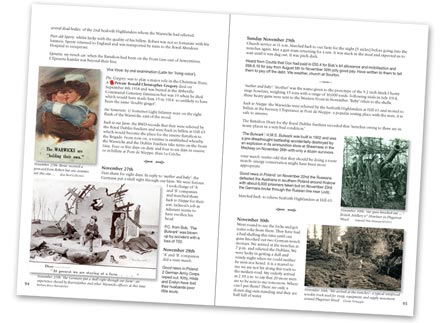

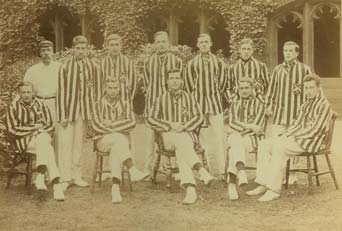
Illustrations from the top :
• Page spread 94-95
• Christmas Day 1914: ‘exchanged greetings and gifts’- similar exchanges took place along the lines - Barbara Bruce Bairnsfather
• Bernard Montgomery, the famous 'Monty' seated second from left, served with Robert Hamilton in the Warwickshire Regiment from August to October 1914. It is clear from the diary that they swapped stories of their experiences in the trenches - Simon Sargent

• Pages from the book
• Prince Maurice of Battenberg killed on 27 October 1914
• Nurse Nellie Spindler who died of wounds on 21 August 1917
• The 5 Souls Brothers who fell on the Western Front
• Hangard Communal Cemetery in the Somme - A Hamilton
